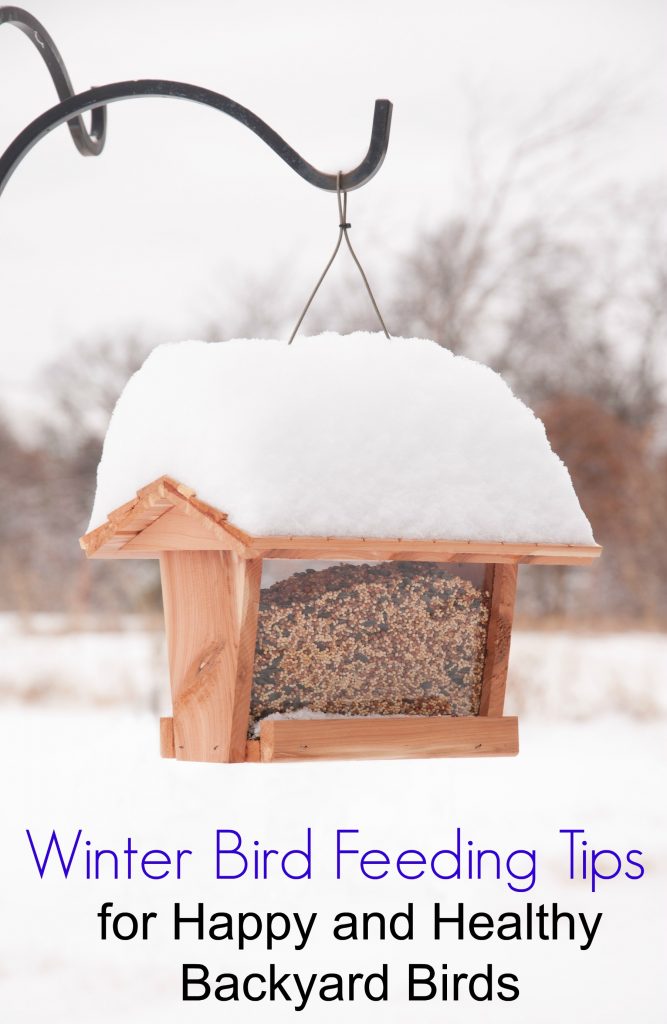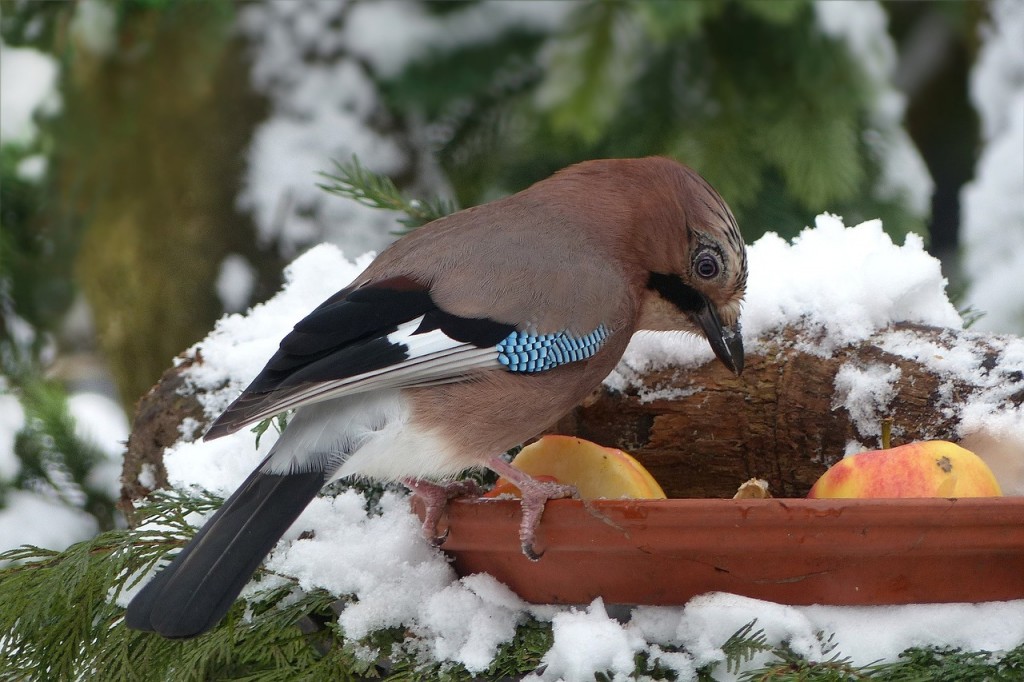Looking for a few winter bird feeding tips to attract your feathered friends? Feeding birds in fall and winter can be a bit more work than just throwing out a bit of seed for them as you do in the spring.
Winter is hard for all backyard birds and providing them with winter bird seed can help make their lives a tad bit easier. Backyard bird feeding during the fall and winter will usually attract a whole different variety of birds to your yard than you do during the spring.
Since most birds fly south during the colder weather, you may very well get to see migrating birds that you have never seen before. With the right feeders and well-chosen wild bird nesting boxes, you can have birds in your backyard all year round!
Posts feature partner companies & may be sponsored. Post contains affiliate links & I will be compensated if you make a purchase after clicking on links. As an Amazon Associate I earn from qualifying purchases.

Table of Contents
Winter Bird Feeding Tips for Happier Birds
Don’t wait till the snow is on the ground to put your feeders out. Start early! Knowing when to start feeding birds in the fall can make or break your bird-watching experience this winter.
If you enjoy backyard bird watching, here are a few winter bird-feeding tips to keep them coming to your yard all year round!
Birds will be hungrier so plan accordingly:
You will need to use larger bird feeders or multiple small feeders when feeding winter birds. They will not have quite as many natural sources of food available during the winter. Since wild berries and bugs are scarce, they will need more winter bird seed from you.

✯Don’t want to miss the next post?✯
Follow Turning the Clock Back on Facebook | Twitter | Pinterest
Or join the private Facebook group for simple tips on going green!
Use winter birdseed:
Winter birdseed generally has more fatty ingredients in it to keep the birds at a healthy weight. Ingredients like black oil sunflower seed, hulled peanuts, nyger seed, and white millet seed are prominent in winter bird seed. Ask at your local bird store for recommendations.
Offer other winter bird food besides seed:
Things like dried mealworms and peanut butter are wonderfully fattening and popular with many backyard birds.

Keep feeders full:
This is one of the most important winter bird feeding tips to remember. If you have attracted winter birds to your backyard, don’t forget about them just because you don’t want to go out in the snow. They came to see you for a reason and may really need your help now that they have arrived.
Don’t forget water:
Water can be tough to leave out for birds in the winter. Birdbaths, ponds, and puddles often freeze over in winter. Try to go out occasionally with a shallow pan of water when the weather is above freezing and leave it near your backyard bird feeder. You can also get something like a solar bird bath or a circulating bird bath that may not freeze as quickly.

Brush off the snow:
If your winter bird feeder is covered in snow, your birds will not be able to dig through it to get to the seeds. As much as you might hate trudging out there in the snow, go out and clean off your feeders and birdhouses regularly. Unfortunately, feeding winter birds can be a bit more work for you but definitely worth it for the joy of watching them on the feeder!
Stamp down the snow under your winter bird feeder:
There are many ground-dwelling birds that still need a bit of winter bird seed from you to thrive. They have trouble finding the fallen seed if the snow is deep. After it snows, go outside and stamp down the snow underneath your bird feeder.

Hang the feeder in cat-safe locations:
Winter birds don’t have quite as much foliage to hide in, making them easy to spot by predators. Hang your winter bird feeders in safe locations, away from the prying eyes of your cat.
Don’t forget to keep feeders clean:
Make sure you bring your feeders inside to clean them occasionally. A good scrubbing before the snow flies is a great start. Keep an eye on the food and make sure it isn’t a wet, frozen mess inside the tube.

Consider placement carefully:
Bird feeder placement in winter needs to be carefully planned out. Placing your bird feeder somewhere with a bit of cover will help prevent snow from building up too quickly. Placing them in an area where they are protected from winds is also important. You can buy a cover for your bird feeder to keep off some of the snow.
I hope these winter bird feeding tips help you keep the backyard birds happy over the coming months. Don’t forget to pull up a chair and grab the binoculars with your children to share the joy of backyard bird watching!
Check out the National Wildlife Federation for more backyard bird-feeding tips. Have any other winter bird feeding tips to share? Like this post about winter bird feeding tips? Pin for Later!


Diane is a professional blogger and nationally certified pharmacy technician at Good Pill Pharmacy. She earned her BS in Microbiology at the University of New Hampshire and has worked in cancer research, academics, and biotechnology. Concern over the growing incidence of human disease and the birth of her children led her to begin living a more natural life. She quickly realized that the information she was learning along the way could be beneficial to many others and started blogging and freelance writing to share this knowledge with others. Learn more about her HERE.

These are really great tips. I have never done winter bird feeding before. Would love to do this and see what kind of birds come.
We live in a bird migration path, so this is actually really good for me to know! We have birds year round in our backyard. WE are always swarming with birds. I love to see all the varieties too. So when we leave out some bird seed, it really draws them close.
HAVE ALWAYS FED THE BIRDS EVERY SUMMER, FALL AND WINTER AND LOTS OF BREAKING OF ICE IN THE FROZEN BIRDBATH. THEN ADD MORE WATER SO THEY CAN DRINK. I HAVE DONE THIS FOR MOST OF MY LIFE FROM THE AGE OF 30 TILL NOW, WHICH I WON’T REVEAL, BUT THEN AGAIN IT REALY DOESNT MATTER, DOES IT? I AM FULL OF LIFE AND LOVE NATURE AND THE WEATHER. GREW UP IN THE NORTH AND WISH I COULD STAY THERE, BUT LIFE ISN’T ALWAYS WHAT WE WANT. PLEASE TAKE CARE OF NATURE BECAUSE THEY DEPEND ON US FOR FOOD. GOD BLESS EVERY ONE OUT THERE AND YOU AND YOURS. THANKS FOR THE MOMENT.
I also grew up in the frozen north. I miss it as well. Have a wonderful holiday season.